Australian Pulse Bulletin
Chickpea: Managing phytophthora root rot
Kevin Moore1, Mal Ryley2, Mark Schwinghamer2, Gordon Cumming3, Leigh Jenkins1
1 NSW Department Primary Industries, 2Queensland Department of Agriculture and Fisheries, 3Pulse Australia.
Background
Phytophthora root rot (PRR) is a disease of chickpea caused by the fungus-like oomycete Phytophthora medicaginis, which is widespread in the cracking clay soils of northern New South Wales and southern Queensland. It can cause significant yield losses in wetter than normal seasons or following periods of soil saturation in normal seasons. Lucerne, perennial and annual medics (Medicago species) and other leguminous plants including sulla (Hedysarum species) and sesbania (Sesbania species) can also host P. medicaginis.
Phytophthora and waterlogging
PRR and waterlogging have similar symptoms and are both induced by transient or prolonged soil saturation and surface water. They usually occur in low lying areas of paddocks, or where water accumulates such as on the low side of contour banks or in watercourses, or where the soil has been compacted or has hard pans.
However, under very wet conditions, entire paddocks can be affected.
Symptoms
Infection by P. medicaginis can occur at any growth stage, causing seed decay, pre- and post-emergence damping off, loss of lower leaves, and yellowing, wilting and death of older plants.
Symptoms are sometimes delayed if temperatures are cool and the soil is moist. Lateral roots and tap root die, or dark brown/black lesions often girdle the taproots. On young plants the lesions may extend up the stem for 10 mm or more above ground level.
-
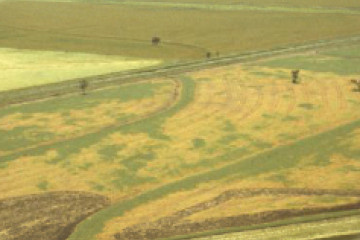
Cultivated areas killed by phytophthora. Only plants on top of contours survived. (Photo: Mark Schwinghamer)
-
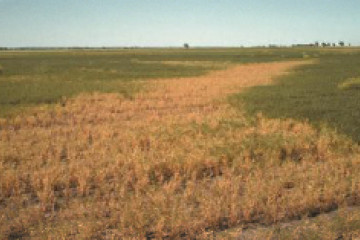
Phytophthora in water course. (Photo: Mark Schwinghamer)
-
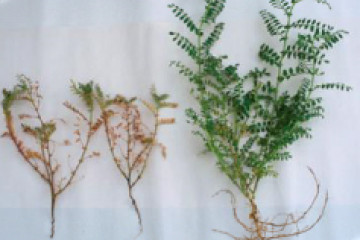
Severely affected plants (left) have no lateral roots and defoliation below tips of stems. (Photo: Joe Wessels)
-
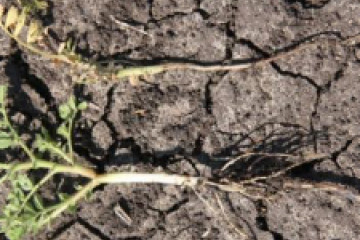
PRR affected plant (right) with lateral and tap root death. (Photo: Mal Ryley)
-
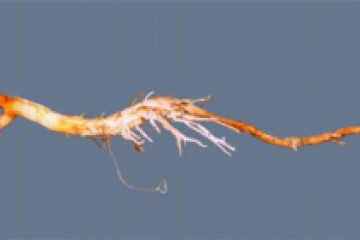
New roots forming from the top of the taproot (PRR). (Photo: Mike Fuhlbohm)
-
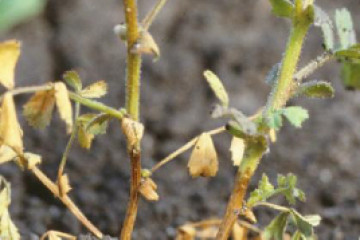
PRR basal lesions extending up the plant stem. (Photo: Mal Ryley)
-
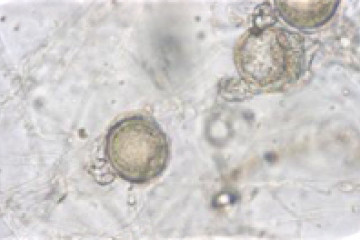
Medicaginis oospores can survive in soil for up to 10 years. (Photo: Gail Chiplin)
Symptoms of waterlogging can be confused with those of phytophthora but differ in that:
- Plants are most susceptible to waterlogging at flowering and early pod fill.
- Symptoms develop within 2 days of flooding compared to at least 7 days for phytophthora.
- Roots are not rotted and are not easily pulled from the soil at first.
- Plants often die too quickly for the lower leaves to drop off.
| Phytophthora root rot | Waterlogging |
| Organism kills roots | Low oxygen kills roots |
| Chickpea, medics, lucerne are hosts | No link with cropping history or weed control |
| Occurs any time of year | Usually occurs later in the year |
| Symptoms onset occurs after a week or more | Symptoms onset occurs quite rapidly |
| Lower leaves often yellow and fall off | Plants die too fast for leaves to yellow or fall |
| Roots always rotted and discoloured | Initially roots not rotted or discoloured (tips black) |
| Plants easily pulled up and out | Plants not easily pulled up initially |
| Manage through paddock rotation varietal choice | Manage through paddock selection, no irrigation in reproductive phase |
Biology and epidemiology
Phytophthora medicaginis survives in soil mainly as thick-walled oospores (Figure 7), but some strains also survive as chlamydospores.
Oospores can survive in soil for at least 10 years. In saturated soil the exudates from the roots of chickpea and other hosts stimulate the oospores to germinate and produce lemon-shaped sporangia. Inside these sporangia, zoospores develop and are released into the soil and surface water, where they are carried by moving water and 'swim' towards the roots and collars of chickpea plants.
Zoospores encyst on the root surfaces and germinate to produce hyphae that invade the roots. New sporangia develop from infected roots enabling further cycles of infection to occur. Later, oospores are formed in the infected roots.
Zoospores are only capable of 'swimming' for a few millimetres, so long distance dispersal of P. medicaginis is by physical movement of soil and water infested with oospores, sporangia, zoospores and/or chlamydospores during floods and irrigation or by machinery.
Management options—PRR
Once a plant or crop is infected with phytophthora, there is nothing a grower can do.
There are no effective chemical sprays a there are for ascochyta and botrytis. Thus, phytophthora can only be managed by pre-sowing decisions and assessing risks for individual paddocks.
Development of the disease requires both the pathogen in the soil, and a period of soil saturation with water. Losses in a phytophthora-infested paddock may be minor if soil saturation does not occur.
The most effective control strategy is to not sow chickpeas in high-risk paddocks, which are those with a history of:
- Phytophthora noted in previous chickpea or lucerne crops.
- Lucerne or annual or perennial medics.
- Waterlogging or prone to flooding.
- Metalaxyl-based seed dressings.
- Avoid poorly drained paddocks and those prone to waterlogging
- Do not flood irrigate after podding has commenced especially if the crop has been stressed.
However, if you choose to sow chickpeas in high-risk paddocks, the following measures will reduce losses from phytophthora:
Grow a chickpea variety with the highest level of resistance.
Particularly in medium risk situations, where medic, chickpea or lucerne crops have been grown in the past 5-6 years.
These are expensive and provide only 6-8 weeks protection. They can be applied with other seed treatments provided all label conditions are followed.

Management options—waterlogging
A rule of thumb is that if the crop has started podding and the soil has cracked do not irrigate.
Overhead irrigation is less likely to result in waterlogging but consult your agronomist.
Useful resources
- Chickpea: Sourcing High Quality Seed
- Chickpea: Effective Crop Establishment
- Integrated disease management in chickpea
- Chickpea best management guide—Northern region
- Chickpea best management guide—Southern region
Key contacts
Disclaimer
Information provided in this guide was correct at the time of the date shown below. No responsibility is accepted by Pulse Australia for any commercial outcomes from the use of information contained in this guide.
The information herein has been obtained from sources considered reliable but its accuracy and completeness cannot be guaranteed. No liability or responsibility is accepted for any errors or for any negligence, omissions in the contents, default or lack of care for any loss or damage whatsoever that may arise from actions based on any material contained in this publication.
Readers who act on this information do so at their own risk.
Copyright © 2015 Pulse Australia
All rights reserved. The information provided in the publication may not be reproduced in part or in full, in any form whatsoever, without the prior written consent of Pulse Australia.
Last updated: 20 November 2015
